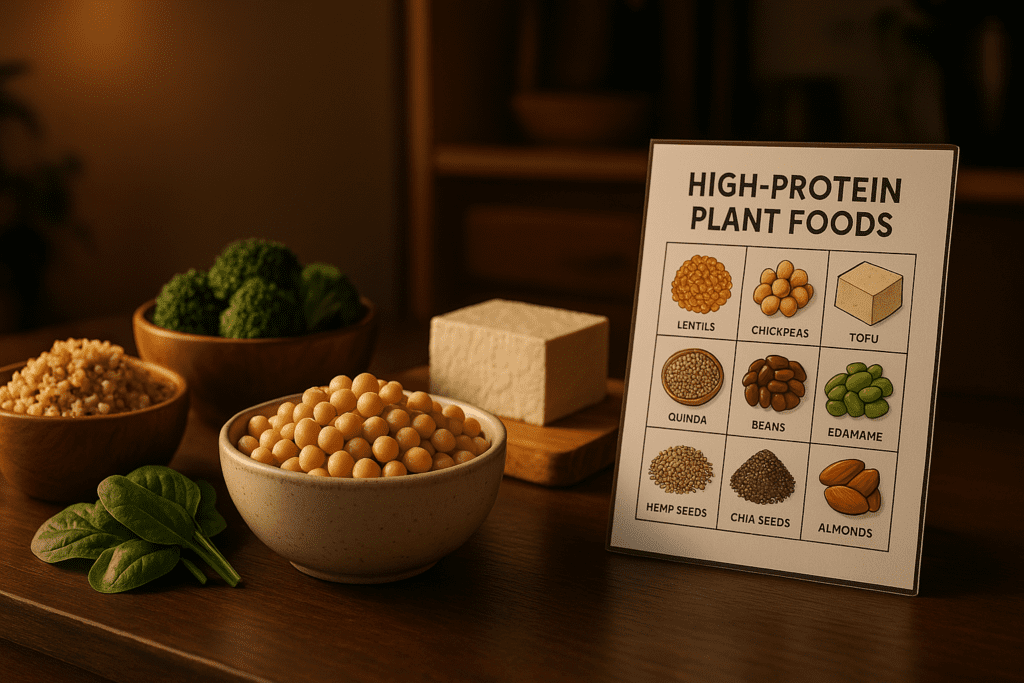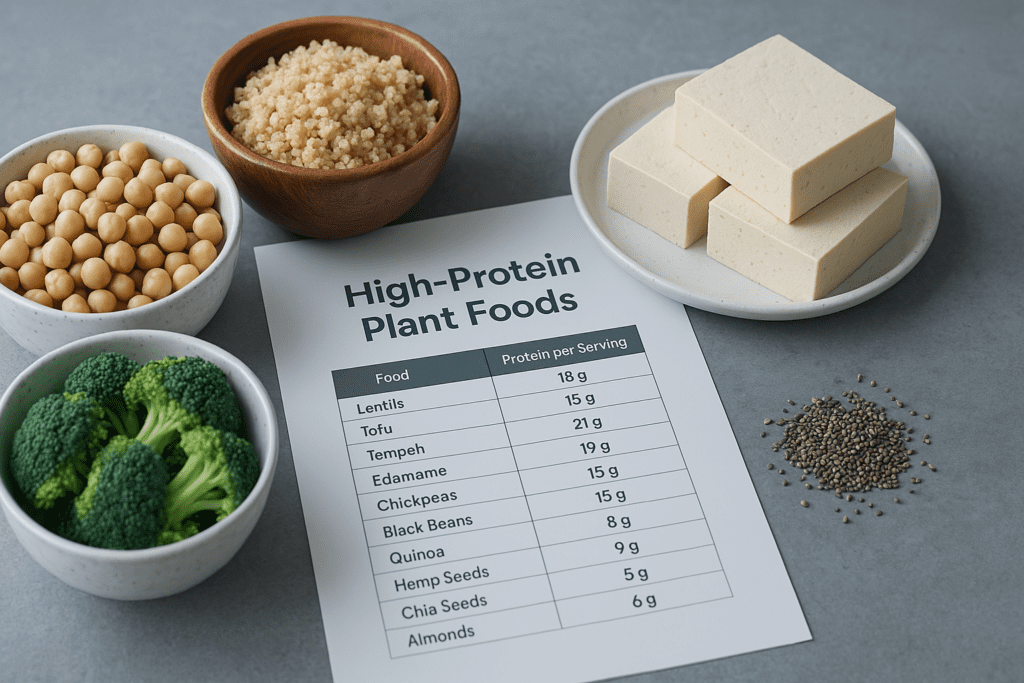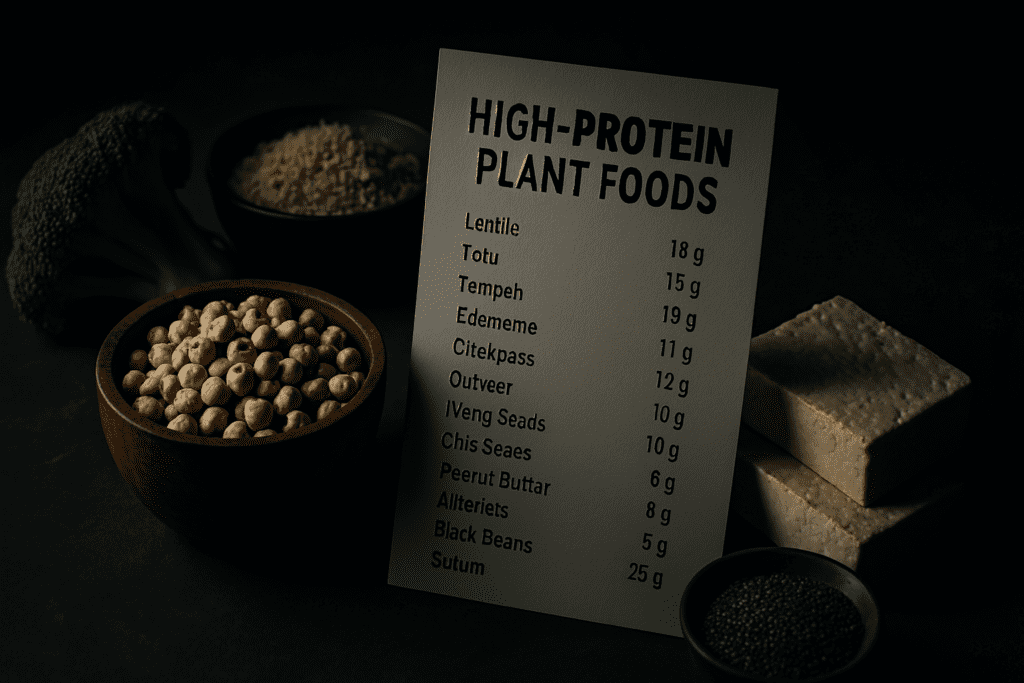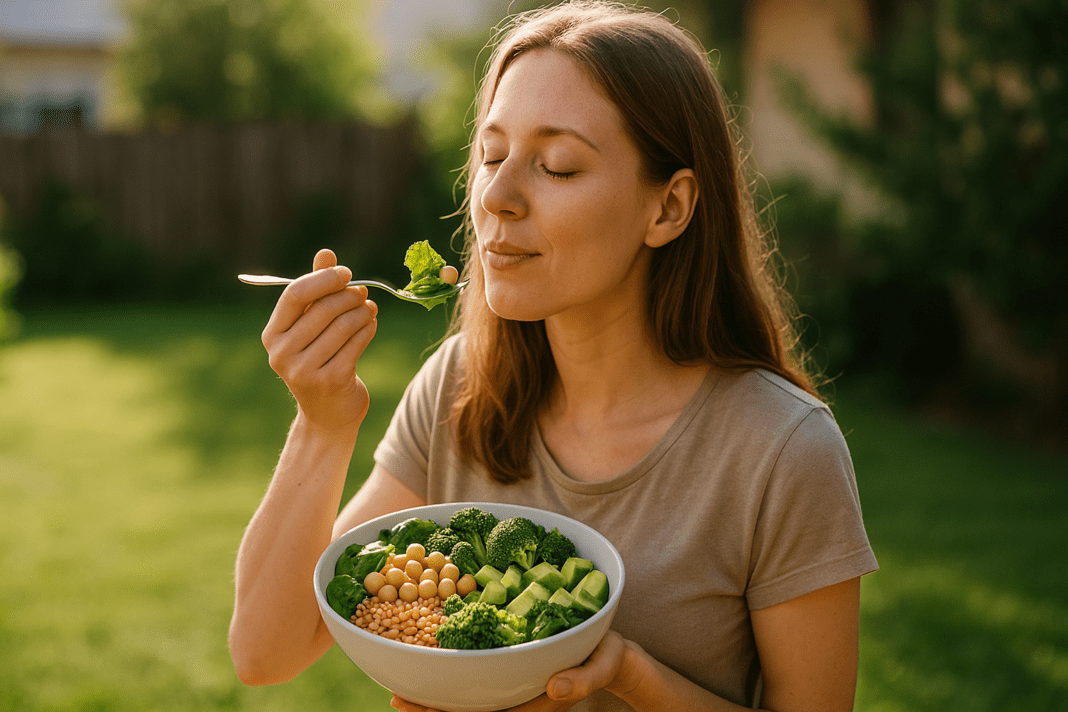Navigating a vegetarian diet while ensuring adequate protein intake can be both rewarding and challenging. While animal products are known for their high protein content and complete amino acid profiles, plant-based diets are rich in nutrients that support long-term health and disease prevention. Understanding how to build a protein-rich vegetarian diet is essential for meeting your body’s needs, whether you’re pursuing fitness goals, supporting metabolic function, or simply striving for overall well-being. With the right knowledge and approach, vegetarians can easily achieve optimal protein levels through a variety of whole, plant-based foods.
You may also like: Best Plant-Based Carbs for Energy and Health: What Science Says About Vegetarian Carbohydrates
In this comprehensive guide, we delve into the science of plant-based proteins, explore the best vegetarian protein sources, discuss how to form complete proteins from plant foods, and provide actionable strategies for maintaining a protein-rich diet. Whether you follow a vegetarian lifestyle for health, environmental, or ethical reasons, this article will equip you with the tools to thrive on a high-protein, whole-food plant-based eating plan.
Understanding Protein Needs on a Vegetarian Diet
Protein plays a critical role in virtually every physiological process, from cellular repair to enzyme synthesis and immune defense. While protein requirements vary by age, sex, activity level, and health status, the Recommended Dietary Allowance (RDA) for most adults is 0.8 grams of protein per kilogram of body weight. However, individuals with active lifestyles, those recovering from illness, or those seeking muscle gain may require more—up to 1.2 to 2.0 grams per kilogram daily.
Vegetarians, in particular, should pay close attention to both the quantity and quality of protein they consume. Unlike omnivores who derive complete proteins from animal products, vegetarians often rely on a variety of plant-based foods that may be lower in one or more essential amino acids. This is where the concept of vegetarian complete protein becomes important. A complete protein contains all nine essential amino acids in sufficient amounts, which the body cannot synthesize on its own and must obtain from food.
While some plant-based foods are naturally complete proteins, many are not. This does not mean vegetarians are at a disadvantage; rather, it requires a slightly more strategic approach to dietary planning. With adequate diversity and mindful combinations, vegetarians can easily meet and exceed their protein needs while also benefiting from the phytonutrients, antioxidants, and fiber that plant foods uniquely offer.

What Are Complete Proteins and Why They Matter
A complete protein, or whole protein, refers to a food source that provides all nine essential amino acids in adequate proportions. These amino acids include histidine, isoleucine, leucine, lysine, methionine, phenylalanine, threonine, tryptophan, and valine. Animal-based products such as eggs, dairy, meat, and fish are naturally complete proteins. For vegetarians, however, identifying and incorporating plant based complete protein sources is key to achieving a balanced intake.
Soy products like tofu, tempeh, and edamame are among the best vegan complete protein sources. Other excellent choices include quinoa, buckwheat, amaranth, and chia seeds. The question often arises: are chia seeds complete protein? The answer is yes. Chia seeds are an example of a whole protein plant based food that also offers omega-3 fatty acids, fiber, and minerals.
Even when individual foods are not complete proteins, combining different plant-based foods can result in protein combinations for complete protein. For example, when legumes such as lentils or black beans are paired with whole grains like brown rice or whole wheat, the amino acid profiles complement each other to form vegetarian complete protein combinations. This principle, known as protein complementation, is foundational in plant-based nutrition.
The Science of Protein Complementation in Plant-Based Diets
Protein complementation is the practice of combining two or more plant-based protein sources to create a complete amino acid profile. While it was once thought that complementary proteins needed to be consumed in the same meal, we now know that consuming them throughout the day is sufficient to meet the body’s needs. The key is dietary variety and regular intake of legumes, grains, nuts, and seeds.
A classic example of this concept is the pairing of brown beans with rice or corn tortillas. In fact, if you’re wondering what pairs with brown beans in incomplete protein to form a complete one, grains are your answer. Brown beans are low in methionine but high in lysine, while grains offer methionine but lack lysine. Together, they fill in each other’s amino acid gaps, resulting in a vegan complete protein combination.
These whole protein combinations are the cornerstone of vegetarian diet complete protein planning. Other synergistic pairings include hummus with whole grain pita, peanut butter on whole wheat toast, and lentil stew with barley. Such combinations are both nutritionally effective and culturally diverse, highlighting the adaptability of plant-based diets across different cuisines and traditions.
Top Sources of Complete Protein for Vegetarians and Vegans
Vegetarians seeking complete protein foods vegan options will find no shortage of delicious, nutritious choices. Soy remains one of the most versatile and widely available vegan complete protein sources. Tofu, tempeh, miso, and soy milk can be easily incorporated into a variety of dishes, from stir-fries to smoothies.
Quinoa is another staple in the realm of complete plant protein. Technically a seed but often classified as a grain, quinoa contains all nine essential amino acids and is rich in fiber, magnesium, and iron. Amaranth and buckwheat also offer complete amino acid profiles and can be used as nutrient-dense alternatives to rice or pasta.
Chia seeds, beyond being a plant based complete protein, are notable for their unique gelling properties and high antioxidant content. Whether stirred into oatmeal or blended into smoothies, they provide a nutrient boost that supports metabolic health and satiety. Hemp seeds and spirulina are also recognized as sources of complete protein, with additional benefits such as healthy fats and micronutrients.
For lacto-ovo vegetarians, dairy products and eggs naturally offer vegetarian complete protein. Greek yogurt, cottage cheese, and eggs not only support muscle maintenance but also provide bioavailable calcium, vitamin B12, and choline—nutrients that can be more challenging to obtain from plant-only diets.
Optimizing Vegetarian Amino Acids Through Meal Planning
To ensure an adequate and balanced intake of vegetarian amino acids, meal planning plays a crucial role. Rather than relying on a few staple foods, successful vegetarian diets emphasize variety. Including legumes, whole grains, seeds, nuts, and vegetables in each day’s meals allows for an array of amino acids that contribute to a complete dietary pattern.
A typical day might begin with oatmeal made with soy milk, flaxseeds, and chopped almonds. Lunch could feature a quinoa salad with black beans, cherry tomatoes, avocado, and pumpkin seeds. Dinner might include a lentil curry served over brown rice, followed by a dessert of chia pudding or a protein-rich smoothie. Such meals incorporate vegan complete protein combinations without requiring animal products.
Snacks are also an opportunity to reinforce protein intake. Nut butters, roasted chickpeas, edamame, and trail mix with seeds and dried fruit offer portable, protein-dense options that support muscle maintenance and appetite regulation. Over time, these food choices support the vegetarian diet complete protein profile required for overall health.
Practical Tips to Meet Protein Goals on a Plant-Based Diet
For vegetarians and vegans striving to meet their protein needs, consistency and mindfulness are key. One effective strategy is to include a source of protein with every meal and snack. This helps distribute protein intake evenly throughout the day, which supports muscle synthesis, metabolic function, and satiety.
Batch-cooking meals with legumes, grains, and vegetables ensures that nutritious, protein-rich foods are readily available. Incorporating high-protein whole foods such as lentils, chickpeas, quinoa, tofu, and tempeh into meal prep routines can significantly boost daily intake. Rotating different sources of protein also supports a broader spectrum of plant based amino acids.
Reading nutrition labels on packaged vegetarian foods can help identify complete protein foods vegan products, such as fortified plant milks and protein bars. However, it is always preferable to prioritize whole foods over heavily processed options. Additionally, if certain amino acids are consistently lacking in your diet, supplementation may be worth considering, especially in periods of high physical activity or stress.
Social meals and restaurant dining can present challenges, but they are also opportunities to get creative with vegetarian complete protein combinations. Choosing grain bowls, bean-based entrees, and globally inspired dishes like Ethiopian lentil stews or Indian dal with rice can ensure adequate protein intake while also expanding culinary horizons.
Debunking Myths About Protein Deficiency in Vegetarians
One of the most persistent misconceptions about vegetarian and vegan diets is that they inherently lead to protein deficiency. In reality, with well-planned meals and diverse food choices, vegetarians can not only meet but exceed protein recommendations. Studies consistently show that vegetarian diets can support muscle strength, bone health, and overall vitality when protein needs are met through plant-based sources.
Another myth is that plant proteins are inferior to animal proteins. While it’s true that many plant sources are not individually complete, the strategic use of complete protein combinations can easily bridge any gaps. In fact, many traditional food cultures have long embraced these combinations. Consider the widespread pairing of rice and beans in Latin America, or lentils and rice in South Asia. These time-tested meals naturally provide whole protein combinations that support lifelong health.
Moreover, plant-based proteins offer additional benefits, such as being lower in saturated fat and cholesterol, and higher in fiber and antioxidants. These factors contribute to reduced risks of chronic conditions such as cardiovascular disease, type 2 diabetes, and certain cancers.
High-Protein Plant-Based Food Chart for Vegetarians
To help vegetarians build meals with confidence, here is a science-backed high-protein food chart that highlights both the protein content and completeness of various plant-based foods:
- Lentils (1 cup cooked): 18g protein
- Chickpeas (1 cup cooked): 15g protein
- Black beans (1 cup cooked): 15g protein
- Quinoa (1 cup cooked): 8g protein (complete protein)
- Tofu (1/2 cup firm): 10g protein (complete protein)
- Tempeh (1/2 cup): 15g protein (complete protein)
- Soy milk (1 cup): 8g protein (complete protein)
- Hemp seeds (3 tablespoons): 10g protein (complete protein)
- Chia seeds (2 tablespoons): 5g protein (complete protein)
- Buckwheat (1 cup cooked): 6g protein (complete protein)
- Almonds (1 ounce): 6g protein
- Peanut butter (2 tablespoons): 8g protein
- Oats (1 cup cooked): 6g protein
- Spinach (1 cup cooked): 5g protein
These foods can be mixed and matched to create protein-rich meals throughout the day. Focusing on diversity ensures that all essential amino acids are represented, supporting a vegetarian diet complete protein profile without the need for animal products.

Frequently Asked Questions: How to Get Enough Protein as a Vegetarian
1. How do vegetarians get enough protein without eating meat?
Vegetarians can get enough protein by diversifying their intake of whole, plant-based foods. This means combining a variety of plant based protein sources like lentils, chickpeas, tofu, tempeh, quinoa, nuts, seeds, and whole grains throughout the day. Many people are surprised to learn that the highest protein vegetarian foods rival their meat-based counterparts when consumed in the right portions. The key lies in understanding how to get protein as a vegetarian through intentional meal planning and combining complementary foods to ensure a full spectrum of amino acids. So, if you’re asking how do vegetarians get protein or how to get protein without meat, the answer is through variety, balance, and smart nutritional pairing.
2. What are some of the best non meat protein sources for vegetarians?
The best non meat protein sources include legumes like lentils and black beans, soy products like tofu and tempeh, and whole grains such as quinoa and buckwheat. These plant based protein sources are not only rich in protein but also offer a host of nutrients like fiber, iron, and B vitamins. Nuts and seeds, especially almonds, chia seeds, and hemp seeds, are also excellent additions for boosting protein intake. Non dairy protein sources like fortified soy milk or pea protein are great for vegans or those avoiding animal products entirely. When choosing high protein vegetarian foods, consider not only the grams of protein per serving but also the amino acid profile to maximize nutrition.
3. How can I increase protein intake without relying on processed supplements?
If you’re wondering how to increase protein intake without using powders or processed bars, the best approach is to emphasize whole foods that naturally contain high amounts of protein. Cooking with textured vegetable protein (TVP), including more legumes in soups and stews, and layering proteinaceous veg food like edamame and spinach into meals are excellent strategies. Sprouting grains and legumes can also enhance protein bioavailability, making it easier to absorb the amino acids your body needs. Another creative solution for how to gain protein without meat is to blend silken tofu or white beans into smoothies, sauces, and dressings. This approach to how to eat more protein offers both culinary variety and improved nutrient density.
4. Are there specific high protein vegetarian foods I should prioritize for muscle gain?
Absolutely. For muscle maintenance and growth, vegetarians should focus on the highest protein vegetarian food options with complete or nearly complete amino acid profiles. Tofu, tempeh, seitan, soy milk, and quinoa should be staples, as they provide optimal ratios for muscle synthesis. Incorporating nuts and seeds like pumpkin seeds and hemp seeds also adds healthy fats and extra protein. One underrated tactic for how to get more protein is to pair a grain like brown rice with legumes like lentils to mimic the amino acid profile of meat. Protein rich vegetarian meals that include strength-boosting ingredients are ideal for active individuals and athletes.
5. What are some practical ways to get protein throughout a busy day?
Busy schedules don’t have to interfere with your ability to consume protein rich vegetarian meals. Keep high-protein snacks on hand, like roasted chickpeas, nut butters, or protein-rich trail mixes featuring seeds and dried fruit. Overnight oats with soy milk and chia seeds make a great breakfast option, and grain bowls with beans and quinoa are easy to prep ahead. If you’re often on the go, consider portable non meat protein snacks like lentil chips, vegan jerky, or hummus with whole grain crackers. Knowing how to get protein without eating meat becomes second nature when you consistently have quick, convenient options at your fingertips.
6. Do vegetarians get enough protein across different life stages?
Yes, vegetarians can absolutely meet protein needs at every life stage—including childhood, adolescence, pregnancy, and older adulthood—with the right dietary choices. What’s important is adjusting portions and food variety based on metabolic demands, which change over time. For example, children and teens benefit from high protein vegetarian foods like lentils, oats, and peanut butter, which support rapid growth. Pregnant individuals may need to increase intake of complete plant based protein sources to support fetal development, especially from non dairy protein sources if they avoid animal products. Seniors, who often face challenges with muscle maintenance, should prioritize the best protein for vegans and vegetarians, including nutrient-dense, easily digestible foods like tofu, tempeh, and soft-cooked legumes.
7. What foods are high in protein and easy to incorporate into daily meals?
Foods like chickpeas, black beans, soy milk, lentils, quinoa, and Greek yogurt (for lacto-vegetarians) are excellent options. These high protein vegetarian ingredients are versatile and fit seamlessly into a wide range of recipes, from soups and salads to smoothies and sandwiches. A practical way to learn how to eat more protein is to follow a vegetarian protein sources chart, which highlights the protein content per serving and helps with balanced meal planning. Look for vegan sources of protein that offer at least 6-10 grams per serving, and try building meals around them rather than treating protein as a side. The more consistently you include plant based protein sources, the easier it becomes to meet your needs.
8. How can I track and balance my protein intake as a vegetarian?
Start by reviewing a reliable vegetarian protein sources chart to familiarize yourself with high-protein foods. Use a nutrition tracking app to log meals and ensure you’re hitting your daily goals. If you’re asking how to get enough protein as a vegetarian or how do you get enough protein on a vegetarian diet, data can help identify patterns and potential gaps. Balance your plate with legumes, grains, and vegetables in proportions that support both energy and amino acid diversity. With practice, learning how to increase protein becomes intuitive, especially when meals are built around diverse proteinaceous veg food choices.
9. Are there cultural or traditional meals that naturally offer high protein vegetarian options?
Absolutely—many traditional cuisines feature high protein vegetarian dishes that exemplify how to get protein without eating meat. Indian cuisine offers dal with rice or chapati, which delivers complementary proteins. Ethiopian meals often include lentils and injera, creating a fiber-rich, protein-dense experience. Mediterranean diets incorporate hummus, beans, and whole grain breads, which are all plant based protein sources. Latin American dishes like black beans with corn tortillas or rice exemplify how to get protein as a vegetarian using complete combinations. These meals not only answer the question, “How can I get enough protein as a vegetarian?” but also prove that non meat protein is delicious, diverse, and culturally enriching.
10. What are emerging trends in vegetarian protein sources and innovations?
Recent innovations are expanding the horizons of non meat protein sources. Fermented plant proteins like tempeh and miso are gaining traction for their digestibility and gut health benefits. High-tech protein extractions from peas, mung beans, and even algae are fueling the next generation of best protein for vegans in the form of clean-label products. Mycoprotein, derived from fungi, is another proteinaceous veg food gaining popularity in sustainable nutrition. As the demand for how to get protein without meat grows, companies are investing in functional foods and fortified options that offer tailored amino acid profiles. Looking ahead, personalized nutrition platforms may soon help individuals determine how to get enough protein as a vegetarian based on genetics, microbiome data, and lifestyle factors.

The Bottom Line: Thriving on a Vegetarian Diet with Complete Protein
Embracing a vegetarian lifestyle doesn’t mean sacrificing protein quality or quantity. With a thoughtful approach to dietary variety, strategic combinations of plant-based foods, and a foundational understanding of plant based amino acids, vegetarians can enjoy a high-protein, health-promoting way of eating. From quinoa and chia seeds to lentils and tofu, the range of vegan complete protein sources is abundant, delicious, and nourishing.
As we’ve explored, the key lies in diversity, planning, and a willingness to explore new ingredients and culinary traditions. Whether you’re crafting meals at home, dining out, or sharing food with friends, opportunities abound to create complete protein combinations that align with your values and support your health goals. Understanding concepts such as what pairs with brown beans in incomplete protein, or how to optimize vegetarian amino acids, empowers you to make informed choices grounded in nutritional science.
Ultimately, a vegetarian or vegan diet complete protein approach is not only possible but preferable for many seeking long-term wellness. With its emphasis on whole foods, sustainable eating, and nutrient density, it offers a pathway to vibrant health that is as flavorful as it is fulfilling.
Further Reading:
The 18 Best Protein Sources for Vegans and Vegetarians
A Comprehensive Chart of Vegan Protein Sources
plant-based protein nutrition, vegetarian muscle building, protein for plant-based diets, meatless protein meals, vegetarian meal planning, amino acids from plants, healthy vegetarian lifestyle, plant nutrition for athletes, vegetarian performance diet, balanced vegetarian meals, vegetarian diet tips, vegan meal prep ideas, complete amino acids from plants, plant-powered nutrition, sustainable protein sources, vegetarian fitness guide, protein in plant foods, high-protein meatless recipes, vegetarian diet for health, nutrient-dense plant foods
Disclaimer
The information contained in this article is provided for general informational purposes only and is not intended to serve as medical, legal, or professional advice. While NewsHealthWatch strives to present accurate, up-to-date, and reliable content, no warranty or guarantee, expressed or implied, is made regarding the completeness, accuracy, or adequacy of the information provided. Readers are strongly advised to seek the guidance of a qualified healthcare provider or other relevant professionals before acting on any information contained in this article. NewsHealthWatch, its authors, editors, and contributors expressly disclaim any liability for any damages, losses, or consequences arising directly or indirectly from the use, interpretation, or reliance on any information presented herein. The views and opinions expressed in this article are those of the author(s) and do not necessarily reflect the official policies or positions of NewsHealthWatch.

